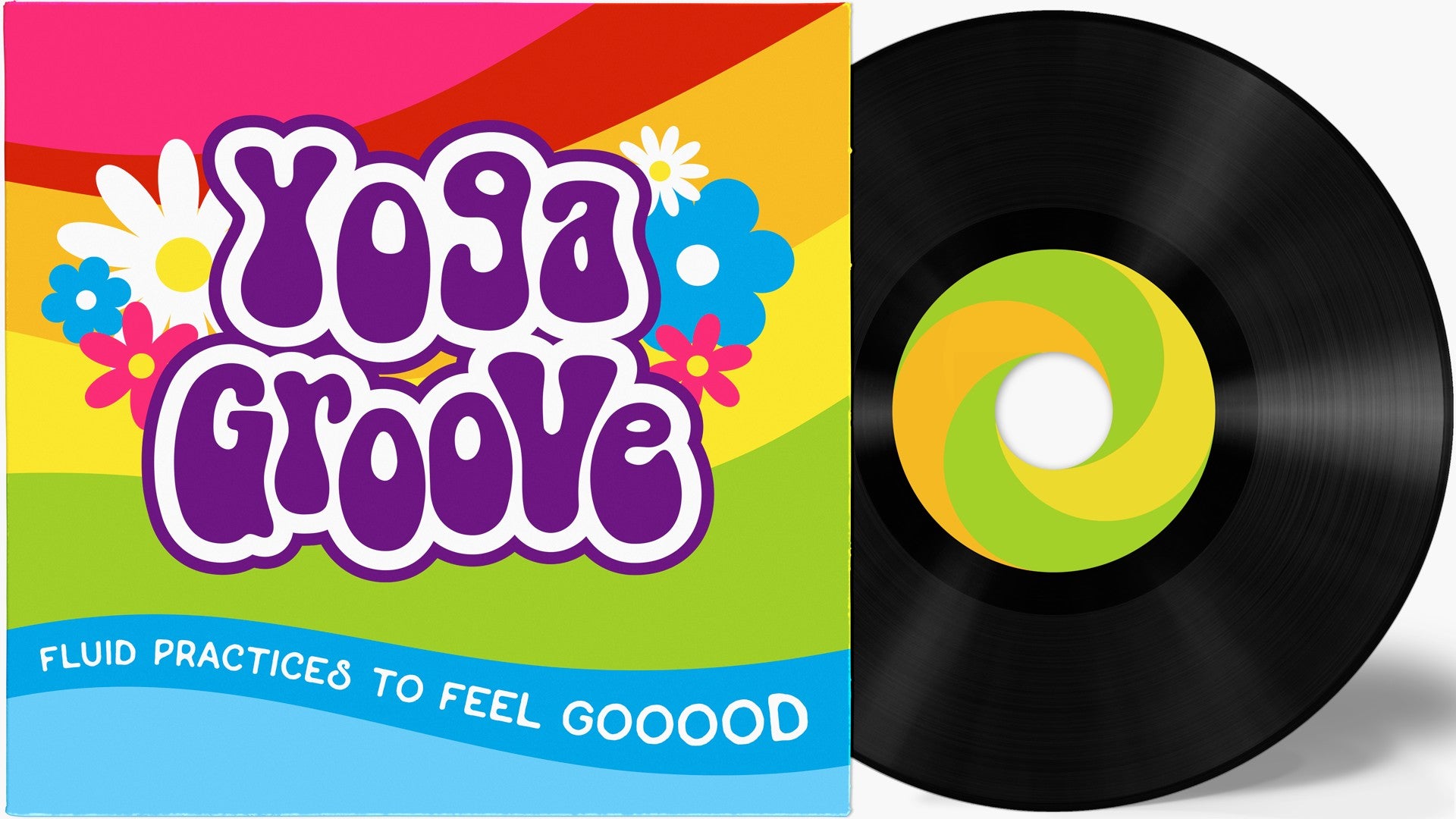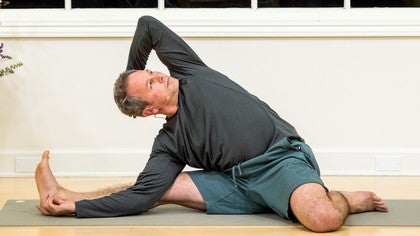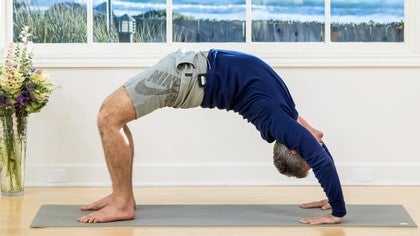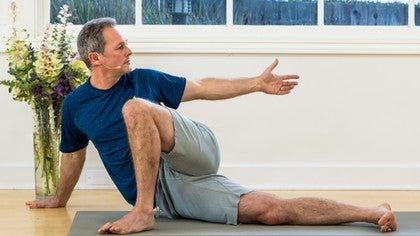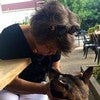Description
About This Video
Transcript
Read Full Transcript
I am ready to lie down. Let's lie down. Anytime down the ground. Let's have a moment of stillness. Now let's get going. So what I'm going to do is I'm going to center myself up on the mat. So my head is not off the mat. I want to release my back. So pull the knees into the chest. And pulse. Little blue blanket. Inhale, balloon in my belly. Exhale, little blue blanket. Inhale. And feel that openness. Now, leave the knees in comfortably. Let the arms go wide like a t-shirt.
Don't worry too much about the alignment. Let gravity do its work. So I'm going to bring the knees down to the left. And as much as I can, I'll keep the knees and the ankles glued together, but at some point there's going to be a trade-off. As long as my awareness is holding my body safe, just knowing what's going on, rather than being somewhere else. That support system should be enough and I'm going to soften and just melt and see whatever happens. And now I look like roadkill. But conscious of the right shoulder melting, it has the exact same buoyancy as the right knee pulling my hips.
So I'm going to let the neck just roll one way and the other way. Rolling with the body, rolling against the natural spiral. And then we get a little bit more aware of our neck. Inhale, center. We'll do that exact same thing on the other side. First, I'll keep the knees together. I'm just going to move something here. And as the knees drop down, it's almost like a tightrope. I release equally the knees and the shoulder and just melt. Looking away. Looking towards the knee direction. Rolling the neck away.
Just letting the neck spiral towards and away. And again, back to center. Keep the left knee into the chest. Right leg extends up to the sky. Now think of the right leg as a drawbridge. So as it's straight and it pulls and lengthens away, I'm going to point the toes, lengthen away. You'll feel your quadriceps, the front of your thigh and your hip flexors and your lower abdomen start to lengthen. And then they cushion down. There should be an opposing action of the right leg lengthening away.
Left knee into the chest. We'll do the exact same thing, but with one leg. Draw the knee across the body. Look away from the bent knee. Expand, make space in the inhale. Not greedy, just curious. Inhale back to center. Exhale, not pulling with the neck, but feeling the chest and the head move all the way up. Squeeze. And pulling both knees into the chest. And then holding the right leg, left leg goes up to the sky. And left leg, again like a drawbridge, it just reaches forward and down.
Point the toes, lengthen out of the front side of the body. Pulling the quads, the hip flexors, the abdomen. Draw the knee across the body. And exhale, spiral. The hand is a paperweight. Whatever happens, happens. When you feel your shoulder lift, don't crank it down. We'll be curious what's holding it up. So you open your chest and back. Forehead knee, give it a squeeze. And down. Now I'm going to stay in the right leg. I'm going to put the hands behind it and just extend it up to what feels comfortable.
One. And rotate the ankle. And change. And then I'm going to bend that right knee. And if you don't know what half happy baby pose is, I'm going to move my leg slightly out. So the knee is outside the armpit and the ankle, as best as I can do, put the ankle on top of the knee. For me, it's like air guitar. So we imagine the heel has the weight of gravity moving the knee down. Moving the knee down. And the hand can act as gravity's assistant, moving the knee down.
If it doesn't go down too much, you can bend the left leg. Just see what it's like. Then we're going to do that extended tree. I love you this much. You reach the leg out to the side and again feel the weight of the leg. Release out and down. And bring the leg up. Now I know for this next pose I'm going to need to bend my leg a little bit, but I'm going to get my hand to the outside. So I bend my knee and my left hand grabs the outside of my right leg.
And it's slowly going to extend. It might not go that far. That is irrelevant. What we're really doing is looking for a kinetic chain or a tension line where I can feel everything in my body. The sensations. Now I'm going to put my right thumb into my hip crease and push like I'm reaching into my pocket. There is that coin I was looking for. And slowly bring it across. I'm only going as far as my hips are still on the ground. So I'm trying to give the outer leg time to release.
So to be quite clear, the tissue on the outer leg is very different. The makeup to the tissue on the inside of the leg. So you've got all these fancy names like Ilio, Tibia Band and Tensor Fascia Lata and Thiracolumbar Fascia. And all that means is it's made of a fibre that's different to the inner side. So we take our time. Just relax a little bit. At some point we say that should be enough and we move across. What we're looking for now is tipping point.
So tipping point is where are you? Once you have tipping point where the leg wants to plop down, we're going to counterbalance by reaching our arm out. So here we go. Reach right arm out. And I might even soften my leg so it can just fold over and stretching you on the leg and the hand away. And I come out of that pose, soften, back up. And this time what I'm going to do is move that with the same hand into half lotus pose.
So I bend the right knee and this time I move the ankle in like I'm hugging the ankle, not the foot, the ankle. We don't want to stretch it. And move it into the opposite hip crease. As we do, I'm going to hold the right foot with the left hand. And now the inner thigh becomes the drawbridge. I move the knee down to the ground and towards the ankle, so away from my hip. The knee moves down and away and my right arm goes overhead. I put it behind my head.
Now imagine your right elbow and right knee moving away from each other and down to the ground. Your inhale, yawn, stretching open. And soften. We're going to try all that on the other side. So release that and we'll just do a little windshield wiper with the hip itself. Just let the leg wobble. Let's go for the other side. So I pull left knee into the chest.
I hold behind the left knee and inhale left leg straight up. And soften. And straight up. And then remember how we did the other side? We did half happy baby. We draw it down.
Air guitar. And I'm going to be forgiving of the tightness instead of, I should be freer. Be curious to know. Be more compassionate. So I'm going to bend my right knee to allow, to be more forgiving. To let that body tissue feel what it's like to just open up.
And now again I'm going to straighten my right leg and that reaching of the right leg helps open a little bit more. Now the next pose we call it lying down extended tree. I love you this much. Here it goes. Open out. And be curious. So when the left leg comes up, I feel this lovely lengthening on the inner thigh.
The abdomen. The groin. Just soften. Feel the weight of that leg. What's holding it up? Maybe you can yawn it away. And back. Now straight away I'm going to change sides.
I don't want to force my way up so I'm going to bring the mountain to Muhammad. I soften my left knee and put the other hand. My right hand to the outside. The baby toe side. And as much as I can, I straighten it out. In the meantime, as before, my left hand goes into the hip crease. So there's a bone down there. They call it the AASIS but just below that you're pushing the thigh away.
It wants to take a shortcut. It wants to cut through the track but we're going to make it run around the track. Hold that hip away and slowly just give it a moment as you draw the foot across but not lifting the hips. Is your sacrum on the ground? Is your spine still on the ground? And it's like you're putting something in the oven. You're just waiting for it to serve its time. A boiled egg or a cake. You're just letting it be there until it's ready.
And a lot of it is you giving yourself time to notice anything. Not to have an agenda. You're just using the tissue to have the attitude that it's okay to not always be turned on. Now we're going to take that further. I'm going to let the weight of the leg come over and again we're going to look for a tipping point. So as the leg comes over, there's tipping point. Stop. Reach the hand away. Still too much weight. The legs soften the knee. And twist. Yawn. Expand.
Hand out of it. Now we're going to come back up. And the same hand is going to move it into, it's called half lotus, where the foot comes to the opposite hip crease. And we hug it in. We have a lot of tissue in there that wants to have the opportunity to open. And as we hug the ankle in, we want the right, the left knee, the bent knee, to just like a drawbridge, move away, step away from the vehicle. Move the knee away and reach the left hand overhead.
I can reach the hand or put the hand behind the head. And notice the armpit, the ribcage, the waist. Just stay here. And again, have that yawn type experience. Inhale, expand. And exhale, soften. Slowly release that leg. And we're just going to give it a little wibble wobble. Now we're going to work on the other side of the hip. Move into the hip sequence. So I'm going to work my way up here. So we're going to go from here now and I'm going to work into opening the hip.
So we squeeze that tissue. And as we talked about, it's nice after you squeeze it to move in. Think of the squeeze as the beginning, the preparation of the opening. This idea of holding and slowly releasing. So I'm going to come all the way over. And I'm going to start with the left leg. So this first pose is called the wheel of life pose. So there's this kind of shape of a right angle, right angle.
I'm going to put a hand on either side of the thigh and just be curious. And I like to think of my heart here literally like a photocopier just scanning back and forward. And even though my heart is scanning over the front leg, what's going on in the hip? So I move heart from knee, heart to ankle. Heart to knee, heart to ankle. And slowly come out. So this is the beginning really of a deeper posture called pigeon.
And I'm going to slide my back leg back. And some people might need props. And actually, there's two alternatives. Get a prop or don't. So what I'm going to do instead of getting the prop is I'm going to release the heel towards the groin till my hip drops down. And there it is. I feel buoyant. Now, I want to make sure the weight is not in the knee and more in the hip that the weight, gravity, that I'm releasing on this through the hips and that, oh, yeah.
So I'm going to tuck the back toes. And as I pull back, again, it reconnects me to the center of my body. It also realigns where the weight is. Release the leg. Inhale up. For me, this is like half upward facing dog. But I have a support system. And I feel that lovely stretch in the back leg. And then you melt, melt, melt, melt, melt. And just relax.
A little while. I'm going to put you in the oven. The whole time, not pushy, curious. There's really only two or three things that happen. You feel too intensely, which at least you can respond to. Or you don't feel at all this muscle amnesia. You might have had disconnection, just a little dull.
Or you're like baby bear and you're just right. And that's your work. And you notice that baby bear shifts from moment to moment. It's not so much a chase. You're releasing with baby bear. There's no resistance between you and baby bear. And I'm going to slowly work my way out of it. It already feels like it's doing its job.
And I am starting to feel slightly more replenished. So I hope this is going to be working for you too. I'm going to swing the back leg around. It's always nice to get a little squeeze in here. And we've done Ardhamats and Dhyasana before where it helps me lift the spine. I have that lovely connection. It feels lovely.
And now I'm just going to move into a gentle twist. Left hand on the outside, left elbow on the outside and inhale tall. And then just turn around and go, what are you talking about Willis? And now we'll do those same three shapes on the other side. So remember the first one, the wheel of life pose.
We make, it's like a little bit of geometry. A little right angle here where the knee is in line with the hip. The ankle is in line with the knee. So we have this lovely U. And we move that back.
And all we're doing, it's more forgiving of the back hip while we work on the front. And we slide. I'm giving away my age. You can't tell from my gray hair. So when I keep you referencing 1980s music videos of people in cars going, cha! And you might notice when you're softer in the tissue, you might go, oh, I haven't gone into this cookie cutter shape of the posture. The work is not there, but really close there in the garden next door.
So when you do the scan, you go, oh. The tour guide is going along this path. And you're just making your own little trail. And I found something I'm going to have to work on. So now I'm going to start moving the leg back.
And like we said before, instead, I can leave the hip back. But this is too much. So I'm going to let the heel slide towards the groin. And that releases the hip. It releases the spiral. And then I can turn my body, tuck my toes.
Boom. Reconnect to center. Release the foot. Push the toenails into the ground. Lift up for half up dog.
And melt down. So my body is tight and more so on one side than the other. And that sensation of almost like a schizophrenic body, in some ways it's good. In some ways it gives me different perspective. And we fold down.
And one more deep breath in and out. Now slowly lift your body up. Slide the back leg around. And just take a second. Get that tall.
So we're just taking out those hinge points. It's more of a spiral than a twerking. Let the shoulder girdle is helping me lift that coat hanger a little higher. Left hand back. And out.
And we release out of that. And we're going to go from here to frog pose. Again, move into the hips and the heart. So similar to what we did, we're going to open up here. I'm going to get the knees somewhat wide.
And you might need extra padding under your knees. I'm okay then. For now, I'll work the knees apart. If I want it to be deeper, I will let the feet be wider. And if I want to be more forgiving.
So it's very similar to the last shape. And then there's the forward and back rock. Toes out. And I feel like I'm moving gently towards child's pose just to be curious. We don't force them.
It's again that idea that when you mop bread on the soup bowl, you just want to wipe the edges. So I'm pushing up against the edge. And just releasing down. If I go to a place where I don't have that leaning against the edge, well, nothing's changing. So we just want to get comfortable with that sensation.
And one more deep breath in. That was good. Come forward. And I'm going to come forward on the mat here. I'm going to leave the legs wide. And it's called makarasana. I'm going to bring the legs in.
Now imagine that with the feet out, and we've established this in the previous shavasana, it opens the inner thighs and softens the belly. Now as I lean on my belly and I stretch my rib cage, imagine that you're breathing into the back door of your back. So I'm breathing through the belly, but I'm pushing into the back muscles. Relax your head and take a deep breath into your lowest part of your belly. And now we're going to soften that.
And it usually feels nice here. We're going to do that half up dog, the action man up dog. So I've been using a lot of geometry again. We're going to bend the leg to 90 degrees. We want to lift in the opposite direction. We lift up. Make sure my right hip is relaxed down.
Open the chest, maybe walk the hands back. What you looking at? Elbow. You look back towards the left knee. The left ankle and then eventually, oh, there you are.
Hello, right ankle. Ages, ages since I've seen you. Back. Down. Change.
So it's really simple stuff, but from all accounts, simple and regular trumps. Well, anything else. Here we go. Down. Knee, ankle.
And other ankle. And back. And it feels lovely on the hip. It really does. So now we're going to come back into a little blue blanket. That was really nice.
Somebody needs a hug. And we just, yes, you are. And we use that paperweight. And around here, just enjoy it, melt with it. And gentle sitting tree.
First external twist, look back. And then forward fold. And up you go. Same leg, twisting the hip for the James Brown. Forward fold.
And up. Move it into gate pose so you pimp slap the inside of your leg. Remember this action we've been working on. Boom, connect, connect, connect, connect, connect, open. Left hand up.
Exhale. And just... No, it's less relevant to grab. I'm just having to use in the tissue to make that loop. But even the hand to the back of my head, that's giving me this lovely connection.
I'm looking up. As long as I have the sensation that my chest is open. And again, pulsing open. So you can stay open or you can go in and out. And soften.
Really nice. Half hero. On the beach. Now you can stay in your elbow. Sometimes I'm wary of...
You know, follow the bouncing ball. But the bouncing ball is your tissue, not the teacher. And I'm just going back to where it feels okay in the body. And I should be clear. It feels okay at different times in the body.
So maybe after four or five seconds. Maybe I can lie down, maybe I don't. Now I'm working the knee towards the ground, the bent knee towards the ground. And that helps open the hip. And soften.
Now to come out of it, if it feels like it's tight, you roll away from the bent knee. And you slowly come up. And we'll do that same thing on the other side. Whatever that was. I think we started with sitting tree.
I think we look back behind our shoulder. I think we folded over our leg. And you should feel this lovely opening in your back, as well as the hamstring. We can always go back to you feel it wherever you feel it, wherever your body needs to feel it. So the shape or offering certain, navigating you certain ways, but you feel it where you feel it.
We go from here to the James Brown. Same fold. Pow, Batman. Open. Exhale.
Lengthen. Again, where if sometimes the tissue doesn't open straight away, so we just, we can play with it or stay still. But always feeling buoyant, even in your stillness. And sometimes the movement is just an over amplification of a quality that you feel you need to work on. Because once you put the handbrake on, you can just check out.
And then once you check out, well, you lose that connection, so then you are vulnerable again. Your safety net is your awareness. We go from here into a lazy half hero. On the beach, I came down on my left arm when I'm stretching my right leg, and then I slowly just check it out. That feels nice.
Now from trying this a couple of times, I want the hip flexor and the quads to open. If my knee pops up, the pressure will go to my ankle and my knee. So when I'm telling the knee to go down, this is what's opening. I need to stay connected here, and I've spent enough time, I think it might be okay to just check it out. And you slowly come up, rolling away, up we come.
I'm going to open the shoulders a little bit. I'm going to leave the hips for now. So to open the shoulders, lying on my belly. Think of my body like a rolling pin. I want to start with my right arm straight out, and I want to make sure that my right shoulder is grounded. Left hand is by the chest. That's just something that's going to help roll my big, heavy body over that direction.
So I'm going to bend my left leg and roll the body. And I really want to feel that the body is doing the work, and nothing's going on in the arm, and the weight of the body. Gravity's greatest is just coming down. And it is like a former martial arts, where you're putting yourself into a tap-out position. But knowing you're in control allows you to stay vulnerable and open.
So relax into it, and feel that kind of little rocket. If you want to go further, the hand either pushes, or the hand goes behind the back. And when the hand goes in the back, it pushes into the sacrum area. What that does is it stacks the shoulders and opens the chest more. Now, your right arm stays straight. That doesn't do anything. That's the receiver in this situation.
If I wanted to do more, I'll put the hand underneath the hip and roll on the hand, flat like a pancake, and that opens and stretches even a little bit more. You do that on the other side. And you might be able to see some of the stuff better on the second side. So I'm going to come down, left hand out, left shoulder down. I'm going to look away from you and rest my head.
Right hand stays by the chest, right leg bends. I'm going to roll the body through a central axis. And like a rolling pin, the foot goes down. Now, if the knee falls in, I won't feel much. I release the hip. And in this particular shape, the hip is what's opening the shoulder.
So I really want to make sure the foot is on the ground, the knee moving away, maybe further away. And maybe I can add to that by bringing the hand behind the back and pushing the right hand into the sacrum. Open my chest more. Or maybe I can lift the hips, squash underneath, and roll a little bit more. So rocking on the hip.
Take a couple of breaths here. And out. Inhale up to all fours. Exhale, child's pose. Just weeping the arms like paint brushes back by the feet and something.
Stay in child's pose for just a few breaths. And if you've got that brushing quality in the breath, you'll notice it'll be very audible on if there's crackles or something in it. So in some of the Japanese principles was the more fluid your breaststroke was in calligraphy. And you could tell if there was a good swordsman there. I want you to use that breath as something that's very specific to your breath, it's your signature, and how you are in this moment, and you have a choice in how you guide that breath. I'm going to ask you to come and sit with me for just a few breaths.
Let the arms rest down, up. When I say down, down in the legs, it could be face down, face up. And we'll have that idea again of too little, too much just right. Usually when we lie down we just want to shut off. Usually when we get up we want to go high octane. And we're just going to see if we can use certain principles to bring everything back into center. So we can recognize the more aligned the spine, the less the muscle tissue has to work.
I'm going to use that awareness, that alertness, to feel good in the spine. And then we're going to check with the breath to see if everything is in sync. So just be tall and comfortable. Bring your hands together. And I thank you for joining me for this wind down practice.
Namaste.
Yoga Groove: Paul Hardiman
Comments
Grateful for your instruction.
You need to be a subscriber to post a comment.
Please Log In or Create an Account to start your free trial.
